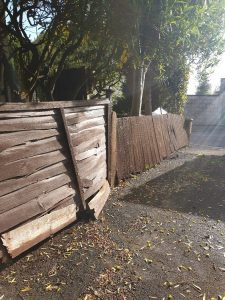Rotten Fence Post Repair
Are your fence posts feeling as weak as a rotten tree branch? It’s time to put an end to the constant replacement and hassle? In this article, we’ll show you the most effective ways to reinforce those rotting fence posts and extend the lifespan of your fence.
Key Takeaways
- Fence posts naturally weaken and rot over time
- To replace a rotted post, adjacent panels need to be removed
- Stabilize rotted posts with steel splints or braces
- E-Z Mender splints are effective for reinforcing 4 x 4 posts
Reinforcing Weak Fence Posts
To reinforce weak fence posts, you can stabilize them with steel splints or braces. When fence posts start to rot, they become weak and susceptible to breaking under stress. This is why it’s crucial to reinforce them to extend their lifespan.
One effective technique is using steel splints, such as the E-Z Mender splints, specifically designed for rotting posts. These splints are made of strong and durable steel, providing the necessary support to the weakened posts.
To reinforce a rotting fence post with steel splints, begin by removing any loose or rotted wood around the post. Then, position the splint on the post so that it covers the weakened area. Secure the splint in place using appropriate fasteners, such as screws or nails, ensuring a tight and secure fit. The steel splint will provide additional strength to the weakened section of the post, preventing further deterioration and potential breakage.
Fixing Sagging Fence Rails
If your fence rails are sagging, you can easily fix the issue by tightening and reinforcing them with metal post-rail connectors. Sagging of horizontal rails is a common problem that can occur due to weathering or loose fasteners. To address this, start by examining the rail connections and tightening any loose fasteners with a screwdriver or wrench. This will help stabilize the rails and prevent further sagging. Additionally, it’s important to apply a wood preservative to the rails to prevent rot and prolong their lifespan.
If the sagging is more severe, you may need to use anti-sag kits. These kits typically include brackets and cables that can be attached to the fence posts and rails to provide additional support. Follow the instructions provided with the kit to properly install it and ensure that the sagging is effectively corrected.
In some cases, the sagging may be concentrated at the center of the fence. In such situations, wedging a brace between the upper and lower rails can help lift and reinforce the sagging section. This can be done by placing a sturdy piece of wood or metal between the rails and securing it in place with screws or nails.
Repairing a Sagging Gate
Reinforce and realign your sagging gate by adjusting the hinges or readjusting the post position.
When your garden gate starts to sag, it can be frustrating and inconvenient. The misalignment of the gate latch bolt and retainer prevents the gate from latching properly, compromising the security of your property. Additionally, over time, the joints of the gate frame may loosen, causing the gate to go out of square. However, there are solutions to these common problems.
To begin, focus on adjusting the gate hinges. By tightening the screws on the hinges, you can lift the bottom of the gate and correct the sagging issue. It’s important to ensure that the gate is level and plumb before tightening the screws. If the hinges are rusty or damaged, consider replacing them with new ones to improve the gate’s functionality.
Another crucial aspect to address is gate latch alignment. Make sure the latch bolt and retainer are properly aligned, allowing them to engage and secure the gate. Adjust the position of the latch bolt or retainer as necessary to ensure a proper fit.
Lastly, don’t forget about gate frame maintenance. Over time, the joints of the gate frame may become loose, causing the gate to sag. By reinforcing these joints with additional screws or brackets, you can restore the gate’s stability and prevent further sagging.
Protecting Wood Fences From Weather
Maintaining the longevity of your wood fences involves applying water-repellent stains or paint every few years. Weatherproofing techniques are essential for preventing rot in fence posts and ensuring that your wood fences withstand the elements. Wood fence maintenance is crucial to protect against moisture, UV rays, and other weather-related damage that can lead to decay and deterioration.
To weatherproof your wood fences, start by cleaning them thoroughly. Remove any dirt, debris, or green or black spots with a solution of chlorine bleach and water. This will help prevent the growth of mold and mildew and keep your fences looking clean and vibrant.
Once your fences are clean, apply a water-repellent stain or paint. These products create a protective barrier that seals the wood, preventing moisture from seeping in and causing rot. Choose a high-quality stain or paint that’s specifically designed for outdoor use and offers UV protection.
In addition to regular staining or painting, it’s important to relieve structural stresses promptly. Fix any broken parts as soon as they’re noticed to prevent further damage. Regular maintenance, such as tightening loose fasteners and replacing damaged boards, will help prolong the lifespan of your wood fences.
Final Thoughts
In conclusion, by following the techniques and tips provided in this article, you can effectively reinforce your rotten fence posts, fix sagging fence rails, repair a sagging gate, and protect your wood fences from weather damage.
With regular maintenance and the use of recommended tools and products, you can extend the lifespan of your fence and keep it looking great for years to come. Don’t let weak and rotting fence posts be a hassle anymore. Take action and enjoy a sturdy and beautiful fence.
If you want to hire a highly recommended professional fence installer then get in touch today to discuss your needs.

